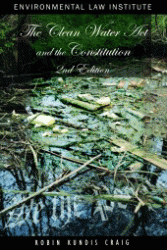Clean Water Act and the Constitution: Legal Structure and the Public's Right to a Clean and Healthy Environment, The, 2nd Edition

In this second edition of a landmark book, author Robin Kundis Craig explores the structural implications for water quality regulation when the primary federal statute for regulating water quality—the Clean Water Act—operates in a context complicated by a variety of constitutional requirements and dictates. After examining the Supremacy Clause, constitutional interstate common law, federal sovereign immunity, the Commerce Clause, the Fifth Amendment’s “taking” clause, the Eleventh Amendment, and the separation of powers principles, Craig concludes that constitutional law has had a more significant effect on the Act’s intent to involve citizens in public interest enforcement than on the Act’s basic structure of “cooperative federalism.”
This second edition thoroughly updates the first edition, particularly in areas where the Supreme Court has issued significant new decisions. For example, it includes discussions of the Court’s 2006 decision in Rapanos v. United States plus the important recent developments in Commerce Clause jurisprudence. Other noteworthy additions include Clean Water Act takings jurisprudence, new discussions of “increased risk” as a basis for citizen suit standing, and the issue of state citizen suit standing after Massachusetts v. EPA.
As Craig reveals, more kinds of constitutional issues have been litigated more often around the Clean Water Act than around any other federal environmental law. Craig argues that environmental constitutional jurisprudence may have progressed to the point where the structure of the Constitution impedes necessary solutions to pressing environmental issues. She concludes by proposing a structural amendment to the Constitution that would restore Congress’s vision of citizen participation in environmental law.